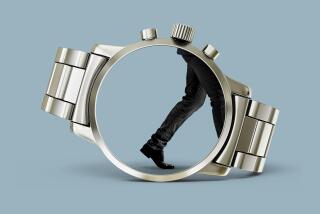Timing was right for his wares
- Share via
It can be tough for any small business to think outside the box, let alone about the box itself.
That’s how Simon Wolf’s fifth-generation family business began in Germany 172 years ago. His great-great-grandfather, Philip Wolf, struggled as a silversmith until he realized that the presentation boxes he made for his metal work were what his customers really wanted.
Now, West Los Angeles-based Wolf Designs is thriving at the edge of another market. The company is capitalizing on resurgent sales of expensive and complicated automatic watches that can cost more than a luxury car.
But Simon Wolf isn’t selling watches. It’s all about the box again. Wolf’s containers cater to the special needs of fine timepieces -- the kind that would never deign to be powered by batteries.
Such watches usually run on an interior rotor that converts arm and wrist motion into the energy that winds the mainspring. Take the watch off, however, and it stops, usually within 24 hours -- a prospect that makes watch aficionados wince. That’s because the intricate contraptions could be ruined by clumsy winding. Such watches also can be difficult to restart.
Many owners prevent stoppages by using a winder, a small box with a rotator that spins the watch enough to keep its mainspring charged. Wolf noticed that most had a flaw: They never stopped rotating, which could damage the timepieces.
“The watchmakers figure you go to sleep at night or you’d go mad. You lie down or take it off for 12 to 15 hours,” Wolf said. “Watches cannot be overwound that way. I thought, ‘Let’s design our own module, develop our own technology and give it a sleep cycle.’ ” .
Wolf’s designs come in several styles, including small cowhide-covered wood boxes and more modern looks made of carbon fiber, glass and aerospace-grade aluminum. Each uses a patented work-sleep cycle, enabling the mainspring to wind down as watchmakers originally intended.
Wolf decided to enter the watch-rotator market in 1999 even though he was doing well selling jewelry boxes and other gift accessories to high-end department and jewelry stores. But, Wolf said, that business was continually being squeezed by the shrinking gap between the cost of making a product and what it could be sold for. What he wanted was a product that would be insulated from those challenges, at least for a while.
“Business is all about what is new and what is just around the corner. You can’t see it yet, but you figure it’s there,” said Wolf, 43, who was born in the English countryside south of London. He attended a boarding school until age 17 but gave up on college after six months, having determined “that they were trying to teach about business but didn’t know a thing about running one.”
His first venture into the winding business was a flop, he acknowledged. The third-party motor was so unreliable that he was forced to refund the cost of each winder, he said. They were also basic motors with only an on and off switch.
By 2002, he had patented a winder, called Module 2.0, which operated on a 24-hour cycle. It did 600 turns over a six-hour period to mimic a typical day’s use and then shut down for the next 18 hours. He also signed a contract with a Chinese manufacturer that agreed to work solely for Wolf Designs, ensuring that his business wouldn’t be shared with potential competitors.
Wolf’s timing was impeccable. The fine-watch business was ready for a leap, despite consumers’ increasing hunger for sophisticated all-in-one personal technology devices.
The U.S. market for ritzy devices that do nothing but tell time is thriving and there is even faster growth among emerging middle- and upper-income consumers in countries such as China and India, according to the Federation of the Swiss Watch Industry.
“There has been an awful lot of growth in self-made entrepreneurs, people learning how to be wealthy as they go. One of the hallmarks of that, besides expensive vehicles and fashion, is a fine, handmade watch with a lot of history behind it,” said Andrew Clayton, group director of research for CurtCo Media Labs, publisher of magazines including Worth and Robb Report.
The value of Swiss watch imports in the U.S. grew more than 7% from 2005 through 2007, according to the Swiss watch federation, to $261 million from $243.4 million. Sales to China rose nearly 31%, to $66 million from $50.6 million, during the same period, and climbed nearly 55% in India, to $8.3 million from $5.3 million. The rise was nearly 28%, to $1.7 billion, among the 30 nations covered in the watch export report.
The number of sales of Wolf’s five rotator models, which include a modular form that can add winders to fit the size of the watch collection, has grown to more than 90,000 in 2007 from 2,000 to 3,000 in 1999, he said. Retail prices for his winders can range from $200 to $1,500, depending on the number of watches they accommodate. In 2007, company revenue totaled about $30 million, he said, up about 10% from the previous year.
Wolf has about 30 employees in California, New York and Hong Kong, with most based in a newly acquired 5,000-square-foot design studio and showroom in West Los Angeles. The walls have been stripped to their original red brick and the ceilings have been removed to expose the galvanized steel ducts. Part of the space includes a display of watch rotator prototypes.
Wolf provides private-label watch rotators for Raymond Weil, Corum, Movado, Neiman Marcus and other expensive watchmakers. But jewelry stores say the watch rotators they sell to customers aren’t the only reason they do business with Wolf Designs.
“Their customer service makes us look good. If there is a problem with one of their boxes, they just come and replace it,” said Beverly Hills Watch Co. owner Armen Eskijian, who sells high-end watch brands ranging from $5,000 to $650,000.
When Chronologic, a Beverly Hills watch and jewelry store, got a request from a well-known television producer for a custom closet display and rotator set for his collection of 48 timepieces, owner Aaron Grunberg called Wolf Designs.
“They are so accommodating. Wolf and one of his engineers drove to the producer’s house and did the measurements and the design and built it on short notice,” said Grunberg, who co-owns the store with his brother Jonas. “He has accounts that are a lot larger than ours, but he did that for us.”
Wolf says he does that to build loyalty, no matter what the size of the account.
“If I make it easier for them,” Wolf said, “they will always come back to me.”
--
--
(BEGIN TEXT OF INFOBOX)
Wolf Designs
Business: Makes winders for high-end watches
Owner: Simon Wolf
Headquarters: West L.A.
Employees: 30
Revenue (2007): $30 million







